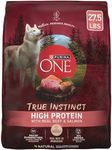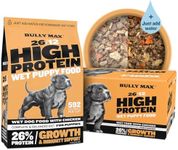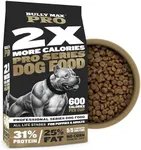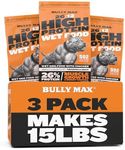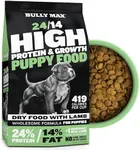Buying Guide for the Best High Protein Dog Foods
Choosing the right high-protein dog food for your pet is crucial for their overall health and well-being. High-protein diets can support muscle development, energy levels, and overall vitality, especially for active or working dogs. When selecting a high-protein dog food, it's important to consider several key specifications to ensure you're providing the best nutrition for your furry friend. Here are the key specs to look out for and how to navigate them.Protein SourceThe protein source in dog food is important because it determines the quality and digestibility of the protein. Common sources include chicken, beef, fish, and lamb. Some dogs may have allergies or sensitivities to certain proteins, so it's important to choose a source that your dog can tolerate well. If your dog is very active or a working dog, you might want to opt for a high-quality animal protein. For dogs with allergies, novel proteins like duck or venison might be a better choice.
Protein ContentProtein content is measured as a percentage of the total food composition. This is crucial because it indicates how much protein your dog will get from their diet. Generally, high-protein dog foods will have a protein content of 25% or higher. For very active dogs or those needing muscle repair, look for foods with 30% or more protein. For less active dogs, a protein content of 25-30% should suffice. Always consider your dog's activity level and health needs when choosing the protein content.
Fat ContentFat content in dog food provides essential fatty acids and energy. It's important to balance protein with the right amount of fat. High-protein dog foods often have higher fat content to support energy needs. For active dogs, a fat content of 15-20% is beneficial. For less active or older dogs, a lower fat content of 10-15% might be more appropriate to prevent weight gain. Always consider your dog's energy expenditure and overall health when evaluating fat content.
Carbohydrate ContentCarbohydrates provide energy and fiber, but in high-protein dog foods, they should be present in moderate amounts. Too many carbs can lead to weight gain and other health issues. Look for dog foods where carbohydrates make up less than 30% of the total composition. For dogs with high energy needs, a moderate amount of carbs can be beneficial. For dogs prone to weight gain or with lower activity levels, opt for lower carbohydrate content.
Ingredients ListThe ingredients list is crucial for understanding the quality of the dog food. Look for whole, named meat sources (like 'chicken' or 'beef') as the first ingredient. Avoid foods with vague terms like 'meat by-products' or 'animal meal.' High-quality dog foods will also include vegetables, fruits, and whole grains. If your dog has specific dietary needs or allergies, carefully review the ingredients list to avoid any potential triggers.
AAFCO CertificationThe Association of American Feed Control Officials (AAFCO) sets nutritional standards for pet foods. AAFCO certification ensures that the dog food meets minimum nutritional requirements. Look for a statement on the packaging that indicates the food is 'complete and balanced' according to AAFCO standards. This certification is important to ensure your dog is getting all the necessary nutrients in their diet.
Life Stage AppropriatenessDifferent life stages (puppy, adult, senior) have different nutritional needs. High-protein dog foods should be appropriate for your dog's life stage. Puppies need more protein and fat for growth, while seniors may need less to prevent weight gain. Always choose a dog food that matches your dog's age and life stage to ensure they are getting the right balance of nutrients.


